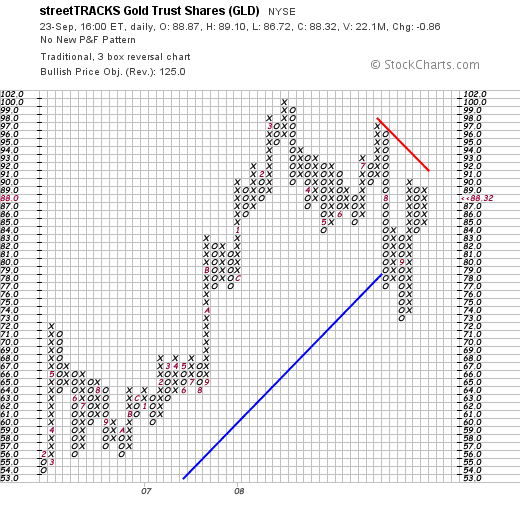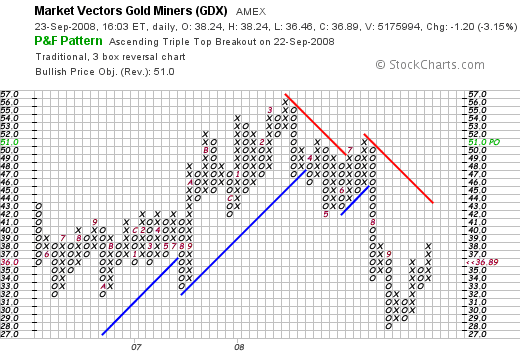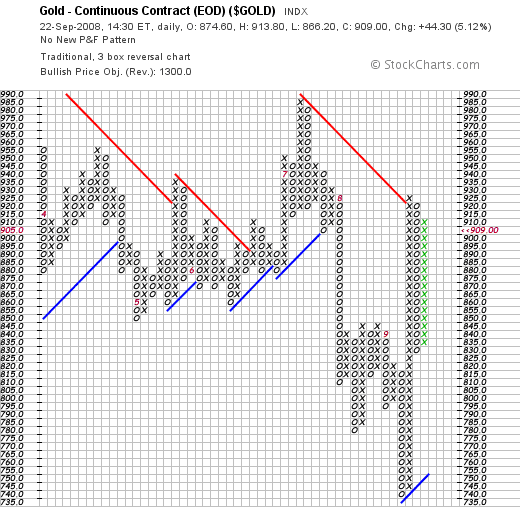http://news.goldseek.com/GoldSeek/1228935840.phpAntal E. Fekete
Gold Standard University Live
Here is an update on the backwardation in gold that started on December 2 at an annualized discount rate of 1.98% and 0.14% to spot in the December and February contracts. It continued and worsened on December 8, 9, and 10 as shown by the corresponding rates widening to 3.5% and 0.65%. It is nothing short of awesome. This is a premonition of a coming gold fever of unprecedented dimensions that will overwhelm the world as soon as its significance is fully digested by the doubting Thomases. The worsening of backwardation must be viewed in the context of the gold price bouncing back from the lows of last week. It shows that the ‘gold bashing’ on Friday was done in the December contract. It is quite revealing that the spot price bounced back more than the futures price. The bulls are on the warpath. They have unearthed the hatchet. They have stopped eating from the hands of the clearing members.
Mish Shedlock published a disdainful criticism of my theory on the worsening backwardation in gold, calling it “nonsense” (see References below). A friend of his owns a seat on Nymex (a branch of Comex) who had this to say:
I have seen countless commodities go into backwardation for numerous reasons, the most frequent being a radical temporary divergence between immediate and overall demand. I have seen backwardations that have lasted years. The article is based on the assumption that a backwardation will necessarily lead to a breakdown of the delivery mechanism. But for every breakdown of the delivery mechanism there have been thousands of backwardations without a breakdown. Only if and when an actual breakdown occurred would the conclusions that the author drew make sense.
Well, well, one can buy himself a seat on the Nymex for sure, and the price is hefty these days, but Nymex does not deliver the understanding of monetary science along with the seat. Nor does any university anywhere in the world. To fill this obvious gap, I founded Gold Standard University Live. It is defunct today, but not because my theories are “nonsensical”.
It is defunct because Mr. Eric Sprott of Sprott Asset Management withdrew his funding after only three sessions, saying that “results do not justify the expense”. Under these circumstances I do what I can to teach all those who want to learn, and pick the “forbidden fruits” of monetary science that have been blotted out from the curriculum ― and from the gold and silver pits of Nymex.
Mish says that “there is nothing special about backwardation, period. OK, they are rare in gold. So what?” Here is what. There is a difference between “rare” and “non-existent”. Backwardation in gold has been non-existent, and for a very good reason, too, as I have explained in my articles. (I also pointed out that there have been ‘hiccups’, or short-lived instances of backwardation. They were temporary ‘logistical’ bumps, always resolved within a day at most, and they never ever spilled over to the next actively traded delivery month.)
Mish needs to educate himself on the fundamental difference between a monetary and a non-monetary commodity, before he can grasp the idea that lasting backwardation in gold is tantamount to the realization that ‘gold is no longer for sale at any price’.
The bottom line is that there is no fever like gold fever. It is akin to St. Vitus’ dance that swept through the Christian world just before the year 1000 A.D. affecting all the people who expected the end of the world to happen at the turn of the millennium. It was far worse than the mania that swept through the world affecting all the people who expected the 2K disaster to happen a thousand years later. The coming gold fever must be distinguished from tulipomania in February 1637, when one single tulip fetched the equivalent of 20 times the annual income of a skilled worker. Gold fever is as different from a bubble as real gold is from fools’ gold. It is visceral. It has to do with one’s instinct for survival. It has no patience with logical arguments. It is highly contagious, ultimately affecting everybody. A bubble that never pops.
You may ridicule the idea that, during a prolonged backwardation, all offers to sell gold will be withdrawn. But a serious analyst must answer the question why hundreds of millions of people having gold coins under the mattress and in the cookie jar refuse to take the bait of ‘risk-free’ profits offered by backwardation. Such a thing would never ever happen to a non-monetary commodity.
The only successful corners in history were gold corners, a.k.a. hyperinflation. Keynesian and Friedmaite economists in the pay of the government thought that gold futures trading will permanently short-circuit the forces of gold backwardation thus preventing hyper-inflation from ever happening. They were wrong.
In an article The Manipulation of Gold Prices (see References below), Professor Emeritus of Economics and former Dean of the School of Business Administration at the University of Indianapolis, James Conrad argues that Bernanke is different. He understands that he needs a much higher gold price in order to increase the efficiency of his airdrops. There is no better way to distribute new money among prospective spenders than putting it into the pockets of the gold bugs. (Conrad admits that he is one.) This will induce a large spending spree, holding deflationary pressures back.
According to Conrad, Bernanke is well aware that the new money he is feverishly airdropping has not stopped and will probably not stop the bloodbath in the stock market. Further devastation of share prices will render pension funds insolvent. To prevent this, the dollar needs a massive devaluation, on the pattern of Roosevelt’s tinkering with the value of gold. I quote:
Anyone who reads the written works of our Fed Chairman will know that Bernanke’s long term plan involves devaluing the dollar against gold. This is the exact opposite of the position of most prior chairmen. He has overtly stated his intentions toward gold, many times, in various articles, speeches and treatises written before he became Fed Chairman. He often extols the virtues of F. D. Roosevelt’s gold revaluation/dollar devaluation back in 1934, and credits it with saving the nation from the Great Depression. According to Bernanke, devaluation of the dollar against gold was so effective in stimulating economic activity that the stock market rose sharply in 1934, immediately thereafter. That is something that the Fed wants to see happen again.
It is only a matter of time before gold is allowed to rise to its natural level. Assuming that about one half of the recent increase in Federal Reserve credit is neutralized, the monetized value of gold should be allowed to rise to between $7,500 and $9,000 per ounce as the world goes back to some type of a gold standard. In the nearer term, gold will rise to about $2,000 per ounce as the Fed abandons its hopeless campaign to support Comex short sellers in favor of saving the other, more productive, functions of various banks and insurers.
Revaluation of gold, and a return to a gold standard, is the only way that hyperinflation can be avoided while large numbers of paper currency units are released into the economy. This is because most of the rise in prices can be filtered into gold. As the asset value of gold rises, it will soak up excess dollars, euros, pounds, etc., while the appearance of an increased number of currency units will stimulate investor psychology; and lending and economic output will increase all over the world. Ben Bernanke and the other members of the FOMC Committee must know this, because it is basic economics.
It is to be regretted that more of Professor Conrad’s admirable paper cannot be quoted here because of lack of space. To summarize: Bernanke is prepared to throw the issuers of paper gold at the Comex to the wolves, as they have become useless, even a nuisance, by now. Besides, the wolves must be appeased lest they devour whatever remains of the U.S. banking and insurance system.
My own position is somewhat different from Professor Conrad’s. In my view we are facing a world-wide elemental grass-root movement: the flight into physical gold ― witness the backwardation in gold. It is irresistible, and will ultimately overtake all other market forces. It will overwhelm official resistance.
An intriguing case can be made, as is attempted by Conrad, that Bernanke is intelligent enough to realize all this thinking that he can harness, if not hijack, the grass-root movement for his own purposes. This is a wee-bit more intelligence than I can give credit for to the Chairman, who is a former academic himself. I find the thought surrealistic that Bernanke wants to use gold as the safety-valve through which he can release steam from an overheating deflation one day, and from an overheating inflation the next.
Be that as it may, the Brave New World of irredeemable currency sans the paper gold factory at Comex will be an entirely different world from what we have been used to for the past thirty-six years. I highlight the differences as I see them. This should be helpful in the long run, even if this backwardation is temporary and gold futures trading will return to normal, since permanent backwardation is ultimately unavoidable.
Item 1: Barrick and other gold producers that still have an open hedge book will go bankrupt.
Item 2: Other gold miners will, one after another, stop selling gold altogether, and go into hibernation.
Item 3: Junior gold mines will put off starting production indefinitely. They will consider their gold ore reserves in the ground a safer store of value than paper money in an insolvent bank.
Item 4: The closing of the gold window at the Comex will furnish an excuse for other issuers of paper gold including the bullion banks to declare bankruptcy fraudulently.
Item 5: GLD and other joint depositories of gold will be under enormous pressure to default and let the owners of the ETF shares hold the bag. Let them sue for the gold. They won’t get it: their contracts give them no right to physical gold. They will get small change, in paper. The principals will cut up the gold pie among themselves. No crumbs will trickle down to shareholders.
Item 6: Even allocated and segregated metal account gold is not safe. The temptation on the account providers to default will be irresistible. They are not going to release the gold until expressly ordered by the courts, and will make sure that no gold will be left by then.
Item 7: Central banks forfeit their gold under leases due to backwardation, causing an uproar of citizens whose patrimony was sequestered and dissipated in such an ignominious manner.
Item 8: The only market for gold will be the fragmented black markets in various countries each charging a price whatever the traffic can bear. All legal protection of the ownership of and trade in gold will be suspended. The Dark Age will descend on the trading world, just as it did when the Roman Empire collapsed.
Our present experiment with irredeemable currency can last only as long as it is able to support futures markets in gold. The declining gold basis is the hour glass: when it runs out and the last grain of sand drops, gold fever will bleed the futures markets of cash gold, and the days of the regime of irredeemable currency are numbered.
Previous episodes of experimentation lasted no more than 18 years, or half as long as the present one which has taken 36 years so far, a world record. Of course, none of the earlier episodes were supported by futures markets. Forewarned, forearmed. Get ready and move closer to the doors. When the curtain falls on the last contango in Washington, there will be panic and some people may get trampled to death at the exit.
Dear Mish, lower your gun. The topic of gold backwardation is not for you.
References
Monetary versus Non-monetary Commodities, April 25, 2006
The Last Contango in Washington, June 30, 2006
Red Alert: Gold Backwardation!!! December 4, 2008
Has the Curtain Fallen on the Last Contango in Washington? December 8, 2008
These and other articles of the author can be accessed at the website
www.professorfekete.comThe Nonsense about Gold Backwardation, etc., by Mike (Mish) Shedwick, December 7, 2008,
www.globaleconomicanalysis.blogspot.comThe Manipulation of Gold Prices, by James Conrad, December 4, 2008,
www.seekingalpha.comGold in Backwardation? Not so fast…, by ‘Hard Asset Investor’, December 2, 2008, ibid.
The Battle against Contango, by Brad Zigler, November 20, 2008,
www.hardassetsinvestor.com







